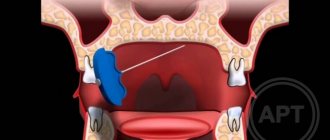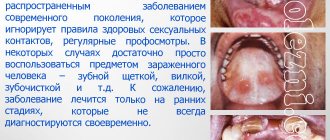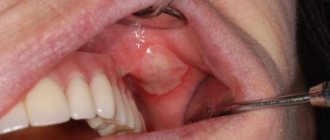Types of chancre
Chancre is an ulceration that occurs 3-90 (on average 21) days from the moment of infection with syphilis, more often in the area of penetration of the pathogen into the patient’s body.
First, a pink spot (inflammation) forms on the skin, then a dense nodule appears in this place, after 7-10 days it becomes necrotic and turns into an ulcer or erosion. If the resulting chancre is not accompanied by itching or pain, then it is called syphiloma. Syphiloma has a regular round or oval shape and clear boundaries that protrude above the skin. The edges are dense, roll-shaped. The bottom of the syphiloma is red, less often – meat-colored, maybe red-brown, and the chancre itself looks varnished, due to the characteristics of the wound.
The size of syphiloma varies from 5 to 30 mm, but there are ulcers of larger or smaller diameter. The main symptom of chancre is a cartilaginous compaction at the base of the ulcer, which can be felt upon palpation. When pressed, the chancre is painless. The skin around the ulcer is clean, without signs of inflammation.
Chancre is formed due to the penetration of Treponema pallidum (spirochete) into the body. For reproduction, the temperature of the human body is suitable for it and after entering the body it actively forms syphilomas. The chancre themselves can be of different types, shapes and sizes.
Classification
By quantity
Single - chancre in the form of a separate neoplasm, or multiple, which looks like several ulcerations.
By origin
Twin chancres occur during simultaneous infection - when the pathogen enters the patient’s body not in one, but in several “places”. That is, instead of one chancre, two or more can be found.
Chancres formed as a result of infection at different times. They appear one after another, in approximately the same place.
The so-called “kissing” chancre, which occurs on contacting surfaces.
Concomitant diseases can contribute to the formation of multiple syphilomas:
- scabies
- acne
- skin injuries
By depth of penetration into tissue
Syphilomas have different depths of tissue damage.
Ulcerative lesions affect the deep layers of the skin. They can pass through the dermis - right down to the subcutaneous tissue. I have a rough bottom covered with purulent plaque. Erosion is located closer to the surface. The bottom is smooth, shiny, and shaped like a saucer.
To size
In addition to standard sizes from 5 to 10 mm, there are giant and dwarf chancres.
Giant chancres are extremely rare and can reach up to 20 cm in diameter. They are localized mainly in areas of accumulation of fatty tissue: on the abdomen, thighs, and pubis. Syphilomas are called dwarf and are the size of a poppy seed - 1-2 mm; they can only be seen through a magnifying glass. They are rare.
By location
Chancre can be located on different parts of the body:
- genital syphilomas are located on the genitals
- extragenital - on any other parts of the body outside the genitals (Fig. 1)
- bipolar syphilomas occur simultaneously both on the genitals and outside the perineum.
Figure 1. Chancre on the index finger of the left hand and in the area of the inner corner of the left eye. Source: CC0 Public Domain
By shape
In addition to the classic round shape, chancre can have a different appearance.
Slit-shaped syphilomas look like cracks. They can form in the corners of the mouth, on the tongue, near the anus. They are rare. Located in the corners of the mouth, they can be perceived by the owner as non-dangerous “jams”.
Cortical chancre is not like ordinary syphilomas; it is not concave in shape and is covered with a crust. It usually forms on ulcers that are located in places where their contents dry out easily: the surface of the nose, face, corners of the mouth.
Diphtheritic chancre is covered with an ash-gray film, similar to diphtheria. Happens quite often. It can be localized in any area.
The burn chancre quickly increases in diameter, while its borders lose their regular shape and clear outline, and the bottom changes from smooth to red-grained (Fig. 2). Typically, primary syphilomas do not tend to grow. This is an exception.
Figure 2. Burn syphiloma. Source: CC0 Public DomainCaption
Erosive chancre includes many erosions; ulcers can merge. Formed exclusively on the mucous membranes of the genitals.
Chancroid herpetiformis is named for its resemblance to genital herpes. This is an erosive formation, in the field of which there are many small ulcers with clearly defined edges. Similar to Folman's balanitis, but in this case the ulcers do not merge.
Signs and symptoms of syphilis in women during the primary period of the disease
Chancroid in women has its own characteristics, which depend on their location:
- erosive chancres are more often located in the area of the labia majora, indurative edema is less often recorded;
- chancre located in the area of the urethra always has a dense base;
- in chancre located in the area of the vulvovaginal fold, the compaction at the base is not pronounced;
- primary syphilomas, located on the cervix, are erosions of round shapes, with a flat bottom, clearly defined boundaries, intense red color, scanty serous discharge;
- when lymphatic capillaries are damaged and lymph outflow in the area of the clitoris and labia is impaired, unilateral indurative edema occurs, characterized by a significant increase in the organ, which becomes dense, dark red in color, often with a bluish tint. After pressing, there is no hole left. There is no pain. The swelling subsides slowly even with treatment.
- Primary vaginal syphiloma is extremely rare;
- in the area of the nipple in women, chancre is recorded in the form of erosions, usually single, with pronounced compaction at the base, covered with a crust;
- The crescent-shaped crack has a primary defect localized at the base of the nipple.
Rice. 12. Primary syphilis in women on the labia majora (photo on the left) and cervix (photo on the right).
Rice. 13. The first signs of syphilis in women are primary ulcers on the genitals.
Rice. 14. The photo shows an atypical form of chancre in a woman - indurative edema (photo on the left) and a primary defect in the nipple area (photo on the right).
The appearance of an erosive ulcer on the genitals or inducing swelling of the labia majora is the first sign of syphilis in women.
Localization
Since syphilis is transmitted primarily through sexual contact, chancroid is most often localized on the genitals. However, clinical practice shows that syphilomas are almost as often found in the mouth and anus.
This means that chancre can appear anywhere, the place of its localization can be:
- penis and scrotum
- labia and clitoris
- posterior commissure and anal area
- pubis
- oral cavity: lips, gums, tongue and throat
- inner thighs
- chest and stomach
- face
- rarely - eyelids, conjunctiva of the eyes
Chancre can be located inside the genital organs, for example, on the walls of the vagina or cervix, then syphiloma is difficult to detect.
Signs and symptoms of syphilis in men during the primary period of the disease
Hard chancre in men has its own characteristics, which depend on their location:
- small erosive chancres are often located on the head of the penis;
- ulcerative chancres are located in the head groove, they are large in size, and have a powerful infiltrate at the base;
- primary syphilomas, located on the frenulum of the penis, have an elongated shape, are easily injured and bleed during erection;
- in primary syphilomas located on the sides of the frenulum, there is no compaction at the base;
- in the region of the edge of the foreskin there are linear chancres;
- the seal at the base of the chancre, located in the area of the inner layer of the foreskin, looks like a visor;
- the hard chancre located on the crown of the glans penis resembles a swallow's nest;
- when located in the urethra, chancres have a dense consistency, are painful on palpation, always bleed, urination is also painful, scanty serous-bloody discharge is noted, in some cases, when cured, a cicatricial narrowing of the organ occurs;
- when the lymphatic capillaries are damaged and the outflow of lymph is impaired in the area of the scrotum and penis, indurative edema occurs, characterized by a sharp increase in the organ, which becomes dense; after pressing, no hole remains. There is no pain. The swelling subsides slowly even with treatment.
Rice. 10. Primary syphilomas in men - localization on the head of the penis (photo on the left) and in the area of the inner layer of the foreskin (photo on the right).
Rice. 11. Ulcerative chancre, located in the head groove, is large in size, has a powerful infiltrate at the base and is linear in direction.
Stages of development
Incubation period
The incubation period - from the moment of infection to the appearance of symptoms of the disease - lasts on average from 2 weeks to 2 months, although observations of longer duration are known. It all depends on the state of immunity at the time of infection. Long asymptomatic periods usually occur in people who were taking antibacterial drugs to treat other diseases at the time of infection.
During the incubation period, Treponema pallidum multiplies in the lymphatic system until it reaches a maximum concentration. They then enter the bloodstream and spread throughout the body. At this time, the disease does not manifest itself in any way and is not detected in blood tests, but the person is already infected. Without realizing it, he or she is putting the sexual partner at risk if they have unprotected sex.
Important! Treponema pallidum can reproduce in a small temperature range, around 37 °C. Therefore, to treat syphilis, the method of pyrotherapy is practiced - increasing body temperature. The patient is given drugs that increase body temperature, as a result of which treponema is deprived of the opportunity to reproduce. This method is considered the most effective for nonspecific treatment of syphilis.
Chancre formation
Figure 3. Development of syphiloma.
Source: CC0 Public Domain Once in soft tissue, treponema begins to actively multiply. During this period, a slight increase in temperature and an increase in nearby lymph nodes, which can be palpated, are possible. Inflammation develops at the site of infection - this is how immune cells try to destroy the enemy.
From the outside, the inflammation site looks like a bright pink patch of skin. Then a characteristic dense nodule forms on the skin - the rudiment of the future chancre (Fig. 3). It enlarges, thickens and after a week and a half ulcerates.
If the ulcer is covered with a crust, then the chancre is also called cortical. If you press on it, a yellowish liquid will come out, in which there is a high concentration of treponemes. This type of syphiloma is called “crying chancroid.”
Discharge from chancre is contagious, and contact with it can transmit infection. This danger is especially high when chancre is located in the mouth - there is a high risk of infecting a partner with syphilis even through a kiss.
The formation of chancre indicates the end of the incubation period and the onset of the primary stage of syphilis. Chancre does not bother the wearer with either itching or pain, which is bad - a person may simply not pay attention to it and waste time.
The primary stage is the most favorable for the destruction of the pathogen. During this period, a complete and rapid recovery is possible with timely administration of antibacterial therapy. In the future, coping with the disease will become more and more difficult.
Healing chancre
An ulcerated chancre lasts 6-7 weeks, then healing begins. Erosion can pass without a trace, but sometimes it leaves a dark pigment spot. When the ulcer heals, a scar remains. A few days before the chancre disappears, profuse itchy rashes may appear on the body.
At this stage, syphilis enters the secondary stage.
Important! Healing of chancre is often mistaken for recovery. This is wrong. In fact, the disease continues to develop, spreading throughout the body.
What is the difference between soft chancre and hard chancre?
There is a chancroid similar to hard - soft chancre (chancroid). It, like syphilis, is sexually transmitted, but occurs due to infection not by Treponema pallidum, but by bacteria of the genus Haemophilus influenzae.
Chancroid differs from hard chancroid in the following ways:
- there is no hard cartilaginous base (that’s why chancroid is called “soft”)
- the edges of the ulcer are not hard, but soft, spreading
- characterized by copious discharge of pus
- painful
- color hot pink, red
Complications of primary syphilis
When a secondary infection occurs, the clinical manifestations of chancroid may change. Inflammation of the glans penis (balanitis) and the inner layer of the foreskin (posthitis) may develop. Balanoposthitis causes the development of complications such as narrowing of the foreskin (phimosis) and pinching of the head of the penis by the ring of the foreskin (paraphimosis). In weakened individuals, gangrenization and phagedenism develop. Decreased immunity and poor hygiene contribute to the development of complications.
Complications in men develop when hard chancre is localized in the coronary sulcus or on the inner sheet of the foreskin.
- When a trichomonas or bacterial infection is attached, acute inflammation develops around primary syphilomas, which is complicated by narrowing of the foreskin, which makes it impossible to open the head of the penis. The penis enlarges, turns red and becomes painful. Forcible opening of the glans penis can lead to paraphimosis. Failure to provide medical care in a timely manner can lead to necrosis of the foreskin and tissues of the glans penis.
- When infected with B. fusiformis, gangrenization of chancre develops. A black scab forms on the surface of a hard ulcer, which, when sloughed off, reveals a deep ulcer. There is severe swelling and hyperemia of the surrounding tissues. The patient's general condition deteriorates sharply.
- The surrounding tissues are swollen and hyperemic. It's getting worse.
- As the disease progresses, the process spreads beyond the chancre. Bleeding occurs. As a result of necrosis, the head of the penis may be torn away, causing perforation and destruction of the urethra (phagedenism).
Rice. 19. In the photo, urethral chancre complicated by balanoposthitis.
Rice. 20. Complications of chancroid in men - phimosis.
Rice. 21. Complications of chancroid in men - paraphimosis.
Rice. 22. Complicated course of primary syphilomas in men.
Rice. 23. Development of gangrenous inflammation of primary syphiloma.
Diagnostics
Several basic methods are used to detect syphilis:
- Detection of treponema pallidum using a microscope in a scraping taken from a chancre.
- The serological method (Wassermann reaction) - when specific proteins that are produced by the immune system in response to the appearance of treponemes in the body are determined, is not effective for primary syphilis.
- The microprecipitation reaction is a rapid diagnosis, also based on the body’s production of antibodies.
- Specific tests RIF, RIT, RPGA, etc. – difficult to set up, time-consuming and expensive. Used to identify latent syphilis, in complex atypical cases, in differential diagnosis and for the diagnosis of late syphilis.
If treponema is detected immediately using microscopy, additional studies are not required to prove infection. Upon detection of treponema, treatment is prescribed immediately.
Sometimes it is necessary to carry out a whole range of diagnostic measures to establish an accurate diagnosis, so it is impossible to diagnose the disease yourself; you need to consult a doctor.
How chancroid develops
Primary syphiloma forms after the incubation period has passed: 3-4 weeks after contracting the infection. It occurs in places with skin lesions in which natural body fluid contaminated with bacteria has entered: sperm, secretion of the uterine cervix.
An ulcer does not appear immediately. Initially, a red spot appears on the infected area, which, under the influence of treponemas and cells of the immune system, thickens and turns into a nodule. The compaction is not accompanied by pain or discomfort, and therefore often goes unnoticed by the patient.
Over the next 7-10 days, the nodule develops: it increases in size, thickens and then ulcerates. Ulceration can be of two types: superficial, in the form of erosion, or deep, in the form of an ulcer. The ulcer or erosion takes on its final form: it acquires clear, pronounced boundaries, an even oval or round shape.
At the bottom of the manifested syphiloma, a liquid is released containing a large number of pale treponema and cells of the immune system. The bottom itself acquires a pronounced red tint with bluish notes.
This type of chancre persists for 1-2 months, after which the process of healing and tightening begins. This signals the transition of the disease to a secondary, more dangerous and severe stage.
3-4 days before the chancre disappears, multiple rashes appear on the patient’s body, often accompanied by burning and itching.
Treatment
It should be noted: in advanced cases, when it is not possible to get rid of chancre, as well as with extensive tissue necrosis, they resort to surgical removal of syphiloma.
In all other cases, the chancre itself is not treated and specific treatment for uncomplicated chancre is not carried out. For secondary and combined infections, topical antibacterial drugs may be prescribed: baths with benzylpenicillin and dimexide, applications with mercury or mercury-bismuth ointment. If the chancre is located in the oral cavity, rinsing is recommended: a solution of furatsilin, boric acid (2%), or gramicidin (2%).
The main task is to get rid of syphilis as quickly as possible and with minimal losses. Therefore, to treat syphilis, penicillin antibiotics are used - short and long-acting (durant) penicillins: Bicillin-1, Bicillin-5, Oxacillin, Ampicillin (semi-synthetic penicillin). The drug of choice for the treatment of syphilis is benzylpenicillin.
Reserve drugs for penicillin intolerance: tetracyclines (doxycycline), macrolides (azithromycin, erythromycin), cephalosporins (ceftriaxone).
Administration of drugs is by injection - intravenous or intramuscular.
Source: CC0 Public Domain
The treatment regimen depends on the stage of the disease, location, degree of damage, etc. In any case, the dose of the drug and the number of courses of treatment are calculated by the doctor individually.
During treatment, control tests are carried out to confirm the effectiveness of the drugs.
Treatment of syphilis at an early stage is the most effective and creates all the prerequisites for a complete cure without consequences and complications.
Recommendations for the treatment period
During the treatment period, it is necessary to stop sexual intercourse. When chancre is localized on the fingers, it is recommended to wear protective gloves. If syphiloma is found in the mouth, it is necessary to separate personal items from common ones - dishes, toothbrushes, etc.
If there are chancres on the body, the use of bed linen, towels, and washcloths should be individual. Syphilis is not transmitted through public places (toilet, etc.).
Sexual partners of sick people receive preventive treatment without fail, including pregnant and lactating women.
Important! You should definitely complete the full course of treatment! Under no circumstances will syphilis go away spontaneously. Untreated syphilis will move to the next stage, increasing the risk of complications and persistent deterioration of the patient’s condition.
Clinical serological control (CSC)
All family members of the sick person, both adults and children, need to receive preventive treatment after sexual or close household contact with patients with early forms of syphilis. 3 months after the end of preventive treatment, a single clinical and serological examination is carried out.
Clinical serological control (CSC) after the end of specific treatment of the patient is carried out once every 3 months during the first year of observation. Then once every 6 months in subsequent years with non-treponemal (simple serological) tests, once a year with the corresponding treponemal test (a complex test to identify possible latent forms of syphilis), which was used in diagnosing the disease. The duration of CSC is determined individually depending on the results of treatment.
Children born to seropositive mothers who did not have congenital syphilis, regardless of whether they received preventive treatment or not, are subject to observation for 1 year. Children receiving specific treatment are on CSC for 3 years.
Regional lymphadenitis, lymphangitis and polyscleradenitis
Regional lymphadenitis
Regional lymphadenitis (scleradenitis) is, after chancre, the second most important symptom of primary syphilis. Scleradenitis develops 6 - 7 days after the initial manifestation of syphilis - chancre and often on the affected side (unilateral localization).
The lymph nodes are painless, woody in density, mobile, and not fused with the surrounding tissues. Sometimes lymph nodes appear simultaneously with primary syphiloma. Several lymph nodes may enlarge at the same time, the largest of which is located closer to the chancroid. When a secondary infection occurs, the lymph nodes become fused into conglomerates, the phenomena of periadenitis are pronounced, and sometimes fistulas are formed. Syphilitic lymphadenitis resolves slowly.
Inguinal lymphadenitis is often bilateral, it develops when hard chancre is localized on the external genitalia, ulnar and axillary lymph nodes increase when syphilomas are localized on the hands, cervical and submandibular - when localized on the lower lip, preauricular and submandibular - when localized on the upper lip, submandibular , cervical and preauricular - when localized on the tonsils, sublingual - on the tongue, preauricular - on the skin of the eyelids, axillary - when primary syphiloma is localized on the skin of the mammary gland, when chancre is localized in the rectum and on the cervix, the lymph nodes located in the small pelvis.
Rice. 24. Regional lymphadenitis is, after chancre, the second most important symptom of primary syphilis. The photo shows inguinal lymphadenitis.
Syphilitic lymphangitis
Inflammation of the lymphatic vessels (lymphangitis) is the third main symptom of primary syphilis. The causative agents of syphilis multiply in the lymphatic system and the lymphatic vessels are the first to be affected in this process. Lymphangitis begins from the site of primary syphiloma and reaches nearby lymph nodes. The inflamed vessels thicken and become like a dense elastic painful cord. Lymphangiitis, like lymphadenitis, resolves slowly.
Rice. 25. The photo shows sclerosing lymphangitis.
Prevention
Since the mode of transmission of the disease is mainly sexual, preventive measures consist of maintaining fidelity to sexual partners - this is the most effective prevention of sexually transmitted diseases. When having sexual contact with an unverified person, you should always use a condom.
Barrier contraception (condom) provides almost 100% protection against syphilis infection.
In any case, after accidental contact, it is necessary to independently treat the genital area with antiseptic agents: miramistine or chlorhexidine.
If an unplanned contact occurs without protective equipment, or the integrity of the condom is damaged in the process, doctors recommend visiting a prenatal clinic as soon as possible and receiving a preventive injection, which will almost 100% prevent the development of syphilis.
Atypical forms of syphilitic chancre
Atypical chancres are types of syphilomas that differ from the usual types in one or more characteristics.
These include:
- Chancroid felon:
an ulcer with jagged edges that appears on the fingers. Most often it occurs on the index finger and thumb, accompanied by shooting pain, swelling, blue discoloration and suppuration. This is an “occupational disease” of surgeons and gynecologists who violate safety regulations. - Indurative edema:
chancre in the genital area, causing severe swelling, bluish skin and swelling of the genitals. Occurs on the labia and foreskin. Not accompanied by pain or inflammation. - Amygdalitis:
unilateral, less often bilateral chancre, located on the tonsils. Enlarges and deforms the tonsil on which it is located, which can cause pain. The color of the tonsil tissue does not change, so the disease can be confused with a sore throat.
With the exception of these features, atypical forms of chancroid do not differ in any way from the usual varieties. The development of atypical syphilomas, the time of their appearance and disappearance are similar to the classical forms.
The difference between acne due to syphilis and chickenpox
Smallpox syphilide is most easily confused with chickenpox.
This disease is diagnosed mainly in childhood.
In adults it is more severe.
The difference is a pronounced intoxication syndrome.
It occurs 2-3 days before acne appears.
Severe hyperthermia, cephalalgia, myasthenia gravis, and sore throat are noted.
There are many foci of rashes, and they are located in groups.
While with syphilis there are few of them, and they are single.
Another feature of chickenpox is the extremely rapid transformation of morphological elements.
The entire cycle can take only 8 hours.
First, pink spots form.
From them papules are formed.
They turn into bubbles.
They usually contain completely clear liquid.
Unlike syphilis, in which the contents of the vesicles are often purulent.
With chickenpox, there is severe itching of the skin.
Differences between ecthyma in syphilis and normal
Common ecthyma has a staphylococcal or streptococcal etiology.
Rarely it is caused by gonococcus.
With simple ecthyma, a bubble or pustular element is formed.
The morphological element appears only against the background of infiltration.
It dries out quite quickly.
A crust forms.
After it leaves, an ulcer forms, the bottom of which bleeds and is covered with plaque.
Ecthyma heals in 2-3 weeks.
In some cases, it can heal without forming an ulcer.
Main localization:
- hips
- gluteal region
- shins
- hands
The main difference between ordinary ecthyma is that there is no infiltrate around the ulcer.
The crust covers the ulcerative defect completely, not partially.
Because ordinary ecthyma does not have a tendency to infiltrative growth.
Syphilis is treated and not treated
Systematic treatment of syphilis currently gives good results, especially when it is started soon after the first signs of the disease appear. Timely and vigorous treatment of syphilis in the mother during pregnancy is the best way to prevent syphilis in the child. But advanced stages of the disease are incurable.
Treatment of syphilis, as well as gonorrhea, should only be carried out by a doctor. It must be remembered that a cure can be achieved only on the condition that the patient accurately follows every doctor’s prescription and carefully carries out the entire course of treatment.
ONLINE REGISTRATION at the DIANA clinic
You can sign up by calling the toll-free phone number 8-800-707-15-60 or filling out the contact form. In this case, we will contact you ourselves.











